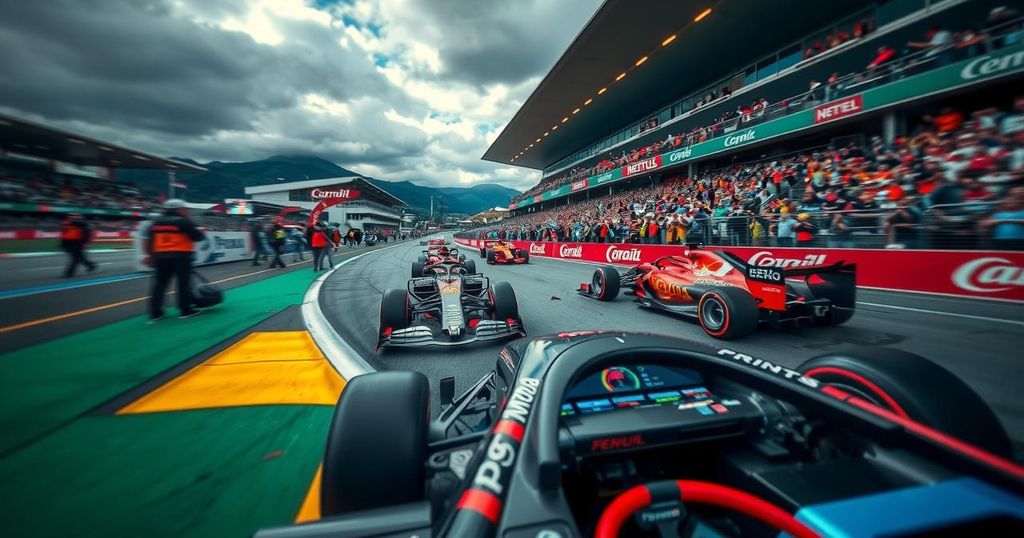Uncertainty in Formula 1 Television Broadcasting as Brazilian GP Concludes Americas Triple-Header
As the Brazilian Grand Prix concludes F1’s triple-header in the Americas, uncertainty looms over broadcasting agreements in Brazil and the U.S. Band faces challenges in Brazil with its 2025 contract amid rising local talent, while in the U.S., ESPN has seen a surge in viewership but may face competition in future broadcasting negotiations.
As the Brazilian Grand Prix closed the F1’s Americas triple-header, the focus turned to the broadcasting landscape for Formula 1 in Brazil and the United States, where current contracts extend through the end of 2025. Following Ferrari’s dominant performance in Mexico, the excitement among global audiences remains heightened amidst the ongoing battle for both world championships. The Brazilian Grand Prix, taking place at Interlagos, signifies the conclusion of three successive F1 races in the region, following the U.S. Grand Prix in Austin and a thrilling victory by Carlos Sainz in Mexico. However, uncertainty looms over the future of broadcasting rights in these crucial markets. Notably, the rise of Brazilian talent Gabriel Bortoleto, currently leading the F2 championship, has added complexity to the dynamics of broadcasting in Brazil. Increased interest could arise should he secure a seat at Sauber, which also raises questions regarding existing agreements. Band, the current broadcaster in Brazil, struggles with fulfilling its broadcasting contract which runs until 2025. Reports indicate that Band is considering dropping its rights for the 2025 season, despite previously signing a renewal to air all Formula 1 races until that point. Although Band has expressed its commitment to the contract, it may seek renegotiation to accommodate shifting circumstances. On the other hand, Globo—which held F1 broadcasting rights for decades—might likely return to the forefront by the 2026 season, and there are indications that discussions for a potential 2025 deal are already underway, pending the resolution of Band’s agreement. The scenario in the United States remains equally dynamic, where Liberty Media has successfully revitalized F1’s presence. ESPN, having resumed broadcasting F1 in 2018, has seen viewership soar, leading to a reported annual commitment of $90 million as the series gained unprecedented popularity in the U.S. The deal allows for live broadcasts of numerous races through 2025, showcasing F1’s growth with American audiences. As the sport continues to find its footing in the U.S., speculation exists regarding future broadcasting rights. Industry sources suggest that the chance of a renewal with ESPN is uncertain, with other broadcasting entities possibly looking to enter the fray for the 2026 rights. In summary, as Formula 1 concludes its series of races in the Americas, the future of its broadcasting deals in Brazil and the United States remains unclear, poised for potential shifts that could affect how fans across these markets experience the sport.
The current landscape of F1 broadcasting rights is in a transitional phase, particularly in Brazil and the United States. As the Brazilian GP signals the end of a competitive triple-header in the Americas, significant attention is being directed towards upcoming broadcasting arrangements. With contracts in place until the end of 2025, fluctuating viewership dynamics driven by rising local talents and the sport’s increasing popularity present both opportunities and challenges for broadcasters. Recent developments involving key networks, such as Globo and Band in Brazil, signify a potential shift in viewership and broadcasting strategies. In the U.S., the substantial success of ESPN’s recent broadcasts points to a growing F1 fanbase, making upcoming negotiations critical. Thus, understanding these intricacies is essential for grasping the financial and promotional landscapes in which Formula 1 operates.
In conclusion, the Brazilian Grand Prix marks a pivotal moment in F1’s Americas racing series, as concerns over broadcasting agreements emerge in both Brazil and the United States. The potential rise of local racing talent in Brazil, alongside the notable success of the sport in the United States, underlines the growing interest in F1 and the complexities of its broadcasting future. The interplay between existing agreements and the aspirations of powerful networks like Globo and ESPN will play a crucial role in shaping the viewing experience for fans in the coming years.
Original Source: www.autosport.com




Post Comment